-
PDF
- Split View
-
Views
-
Cite
Cite
R. Gil-Hutton, P. Benavidez, Southern stars that can be used as unpolarized standards, Monthly Notices of the Royal Astronomical Society, Volume 345, Issue 1, October 2003, Pages 97–99, https://doi.org/10.1046/j.1365-8711.2003.06957.x
Close - Share Icon Share
Abstract
Results are presented from a programme of linear polarimetry to find unpolarized stars in the solar vicinity that could be used as standard stars and are within reach of telescopes in the southern hemisphere. We find up to 10 suitable candidates. On the other hand, among the observed stars, HD 112164, HD 114613, HD 130307 and HD 160691 are objects within 27 pc of the Sun but showed a relatively high polarization in the ≈0.1 per cent level, which must be of intrinsic origin.
1 Introduction
Astronomical polarimetry is a technique that provides useful information about the intrinsic polarization of stars, the density of interstellar matter between the observer and the star under study, and many physical parameters of atmosphereless bodies in the Solar system with accuracy at the 0.01 per cent level (Serkovski 1974; Geake & Dollfus 1986). However, when such an accuracy is pursued it is necessary to know with high precision the instrumental polarization introduced by the polarimetric device and the position angle of the instrumental system. The most reliable procedure to accomplish the instrumental calibration is made at the telescope observing unpolarized and polarized stars during each observing run.
The local interstellar medium around the Sun appears as a relatively depleted and hot region (Cox & Reynolds 1987), and neither the IRAS data nor the more classical reddening measurements provide a sensitive detection of the small amount of dust expected to be present inside this local bubble. Thus, it is reasonable to look for unpolarized stars inside or around this region because the polarization introduced by the interstellar matter is at a minimum, in spite of the fact that it is possible to find unpolarized stars farther than ≈50 pc from the Sun.
Due to the latitude of the observing sites where unpolarized standard stars were observed and the magnitude of these objects (Walborn 1968; Turnshek et al. 1990; Hsu & Breger 1982; Schmidt, Elston & Lupie 1992) it is difficult to find suitable standards for 2-m class southern hemisphere telescopes over large regions of the sky. In this paper we present polarimetric data of 26 dwarf G-type stars within 65 pc of the Sun with right ascension in the range 10–19 h and declination south of ≈0°, with the objective of finding some objects which could be used as unpolarized standards.
2 Observations
The observations were made with the 2.1-m telescope and CASPROF polarimeter of Complejo Astronómico El Leoncito (CASLEO), San Juan, Argentina. CASPROF is a two-hole aperture polarimeter with rapid modulation provided by a rotating achromatic half-wave retarder and Wollaston prism polarizing beamsplitter. The complementary polarized beams are detected with photomultipliers operating in pulse-counting mode and the acquisition and guiding are accomplished with a CCD camera viewing the sky surrounding the entrance aperture. All the measurements were obtained with a standard Johnson V filter bandpass, a 17-arcsec diaphragm and an integration time of 90 s.
The main body of the data presented here was obtained during the periods 2000 April 12 to 14 and 2000 May 2 to 5, where 11 and 17 stars were observed, respectively, but these stars were also repeatedly observed in smaller groups between 2000 June and 2002 July to test the results obtained. As almost all the programme stars are within ≈50 pc from the Sun, we assumed for the reduction process that they are unpolarized objects. Then, the components of the polarization introduced by the instrument for each run are obtained by computing the mean values of the instrumental polarization components of the observed stars. Using these values, we rejected any star with components larger or smaller than 2.5σ from the mean values obtained, and repeated the process until the solution converged. Finally, to find the position angle of the instrumental system we used polarized standard stars.
In Tables 1 and 2 the equatorial coordinates, magnitude, spectral type and distance for the observed stars, obtained from the Hipparcos catalogue, are listed. During the May observing run we also observed the stars HD 112164 and HD 143120, previously observed during the April observing run, so their data are not listed in Table 2. During both runs we also observed two known unpolarized standard stars in order to have control on the solution obtained. The data for all the standard stars, including the total polarization and position angle for the polarized standard stars, were obtained from Turnshek et al. (1990) and are listed in Table 3.
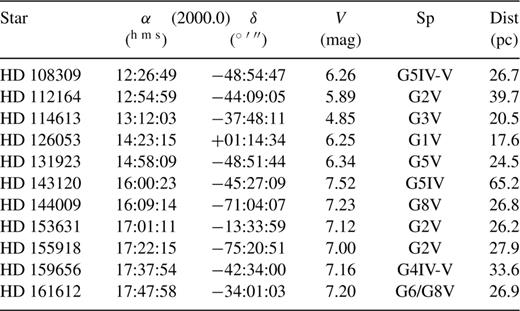
Equatorial coordinates, magnitude, spectral type, and distance for stars observed in April.
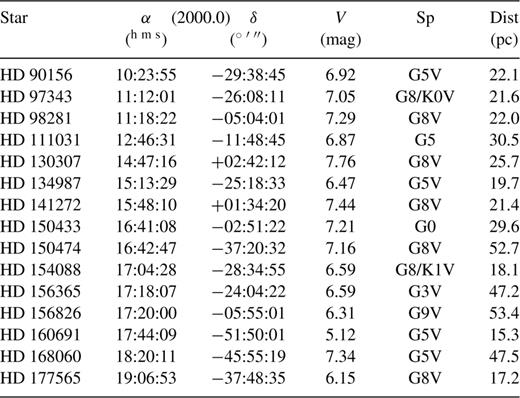
Equatorial coordinates, magnitude, spectral type, and distance for stars observed on May 2000.
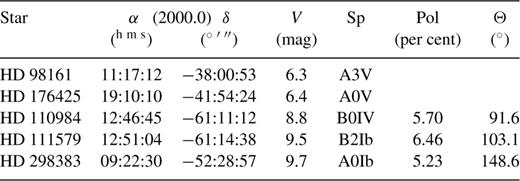
Equatorial coordinates, magnitude, spectral type, total polarization and position angle for standard stars.
3 Results
Using the reduction process explained in the previous section, we rejected the stars HD 112164 and HD 114613 for the April observing run, and found for the components of the instrumental polarization the values Qo=−0.082 ± 0.018 per cent and Uo= 0.058 ± 0.019 per cent. The correction of the position angle of the instrumental system was found as  . In Table 4 the final polarization components for the observed stars during this period, with their errors and number of measurements, are listed. We decided to list only the polarization components because the uncertainty in the position angle is so high for these small polarization objects that it becomes completely meaningless. From the stars observed in April, the best candidates for unpolarized standards are HD 131923 and HD 155918, but the stars HD 143120 and HD 159656 could also be considered. On the other hand, the stars HD 97343, HD 112164, HD 130307 and HD 160691, observed during the May observing run, were rejected by the iterative reduction process. The components of the instrumental polarization were Qo=−0.075 ± 0.017 per cent and Uo= 0.055 ± 0.021 per cent, and the correction of the position angle of the instrumental system was
. In Table 4 the final polarization components for the observed stars during this period, with their errors and number of measurements, are listed. We decided to list only the polarization components because the uncertainty in the position angle is so high for these small polarization objects that it becomes completely meaningless. From the stars observed in April, the best candidates for unpolarized standards are HD 131923 and HD 155918, but the stars HD 143120 and HD 159656 could also be considered. On the other hand, the stars HD 97343, HD 112164, HD 130307 and HD 160691, observed during the May observing run, were rejected by the iterative reduction process. The components of the instrumental polarization were Qo=−0.075 ± 0.017 per cent and Uo= 0.055 ± 0.021 per cent, and the correction of the position angle of the instrumental system was  . In Table 5 the final polarization components for the observed stars during this period, with their errors and number of measurements, are listed. From the stars observed in May, the best candidates for unpolarized standards are HD 90156, HD 150474, HD 156365 and HD 156826, but the stars HD 141272 and HD 177565 could also be considered.
. In Table 5 the final polarization components for the observed stars during this period, with their errors and number of measurements, are listed. From the stars observed in May, the best candidates for unpolarized standards are HD 90156, HD 150474, HD 156365 and HD 156826, but the stars HD 141272 and HD 177565 could also be considered.
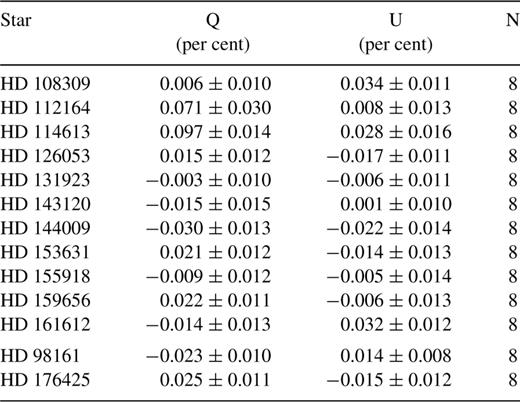
Final polarization components, errors and number of measurements for stars observed in April.
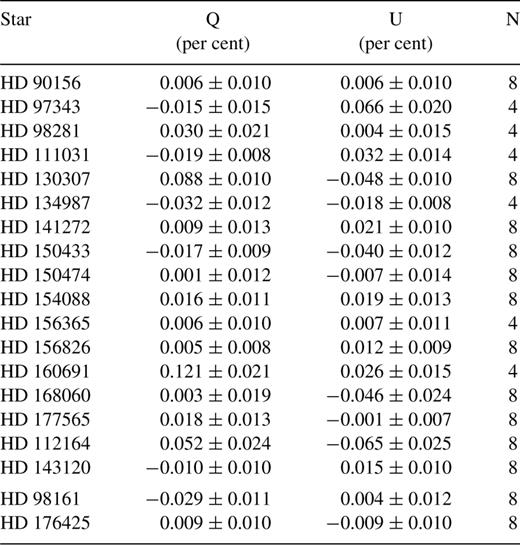
Final polarization components, errors and number of measurements for stars observed in May.
The instrumental polarization and correction of the position angle of the instrumental system appear to be similar in both observing runs, indicating that the instrumental system is steady. The results obtained for the known unpolarized standards, HD 98161 and HD 176425, are also similar in both runs, within the observational errors.
The rejected stars HD 112164, HD 114613, HD 130307 and HD 160691 have total polarization in the ≈0.1 per cent level, but as they are near the Sun (at 26.7, 20.5, 19.7 and 15.3 pc, respectively) the observed polarization is not produced by interstellar dust and must be intrinsic to these objects. They appear as very interesting objects and deserve a more careful study to explain their polarization. In particular, Jones et al. (2002) found two planets orbiting HD 160691, so the excess of polarization observed for this object could be the consequence of the presence of dust around the star produced by the collisional evolution of the planetary system.
The equatorial coordinates, magnitude and spectral type for the stars that we found that can be used as unpolarized standards are listed again in Table 6.
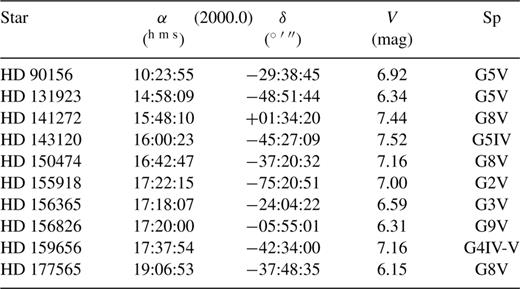
Equatorial coordinates, magnitude, and spectral type, for stars which could be used as unpolarized standards.
4 Conclusions
We presented polarimetric data of 26 dwarf G-type stars within 65 pc of the Sun that can be observed from the southern hemisphere, and between six and 10 of them could be used as unpolarized standard stars. Four stars, namely HD 112164, HD 114613, HD 130307 and HD 160691, which were rejected during the reduction process due to their high polarization appear as objects with intrinsic polarization, which deserves a more careful study in the future.
Acknowledgments
The authors thank M. Catelan for his comments, which helped to improve the original version of the manuscript.
References
Author notes
Present address: Pontificia Universidad Católica, Santiago, Chile.



